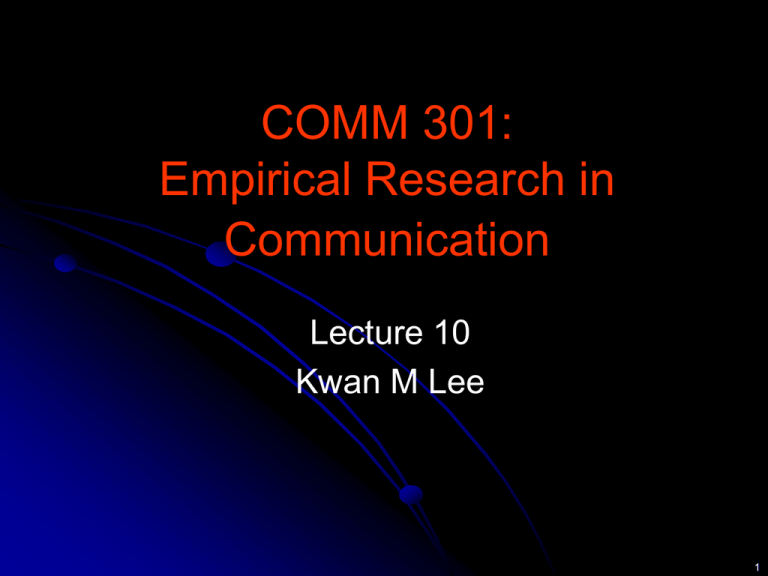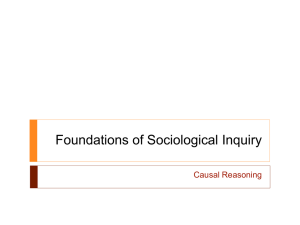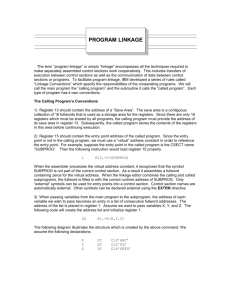lect10_1
advertisement

COMM 301: Empirical Research in Communication Lecture 10 Kwan M Lee 1 Experiments • Things to know by the end of the lecture: – Know advantages and disadvantages of experiments – Know how to achieve experimental control to get causal inference • Factors influencing control • Specific techniques to ensure control – Know the various experimental designs, in terms of • • • • Understand logic behind each design structure, how they look like advantages and disadvantages How to apply 2 Experiments • Experiment – method that allows us to evaluate the influence of some independent variables on some dependent variables – while controlling for other intervening variables 3 Experiments Advantages vs. Disadvantages • Advantages – Allow causal inference – Replication possible by someone else. • Disadvantages – Lack ecological isomorphism – Weak generalizability 4 A note on causality (remember lect2 ?) • 3 requirements for causal relationships – Temporal ordering: cause precedes effect in time – Meaningful correlation: must have a theoretical foundations for observed correlations – No alternative causes (hypotheses): correlation cannot be explained by other factors • Control: the use of techniques for systematically ruling out alternative causes – Alternative hypotheses exercise • E.g. no wash on an exam day 1) no wash is lucky vs. 2) more time spend on reading 5 Factors influencing the amount of control in experiment • Manipulation of independent variable • Ensuring group equivalence • Control of intervening variables 6 Manipulation of independent variable • Active manipulation – Researcher determines participants’ level of exposure to independent variable. – Give some assurance that if dependent variable changes, it is due to the independent variable – E.g., default experiment setting • Passive observation – Cannot be under control of researcher – Natural setting • E.g.,Comparison of two existing classes which have different teaching methods 7 Ensuring group equivalence • Experiments use different groups of participants • treatment group (treatment) • control group (no treatment) • comparison groups (when two or more treatment groups) • Group equivalence assumption – Must ensure that before imposing the treatment, the groups are equivalent with regard to the dependent variables. – How to insure? see next slides 8 How to ensure group equivalence • Random assignment – Participants assigned to treatment or control, or comparison groups by randomized method. – No guarantee of getting equivalent groups • But it usually works! – Can use statistical testing to find out how likely the group is non-equivalent. • Comparisons of variables not related to dependent variables 9 How to ensure group equivalence (cont.) • Pretesting – Groups are measured on the dependent variable(s) before any treatment. – Expectation is that the groups will be similar • If not, non-equivalent with regard to DVs 10 How to ensure group equivalence (cont.) • Matching • Participants in the groups are matched on characteristics important to dependent variable(s) (i.e. matched on intervening variables) – Constancy matching • All participants in all groups kept uniform on the characteristic thought to influence the dependent variable. • e.g. holding gender constant: test only males – Pairing • Each participant in a group is matched with other participants in other group on the variable(s) thought to affect the dependent variable(s) • e.g. for each male (female) in treatment group, there is a male (female) in the control group – i.e., equal # of males and females 11 Control of intervening variables • Eliminate the influence of: – participants (through ensuring group equivalence) – settings (through ensuring settings are different only with regard to manipulations) – individual researchers • use of double-blind procedures • use of scripts. – other factors influencing internal validity (e.g., maturation, attrition.) 12 Experimental designs • Experimental research designs are categorized along four dimensions – – – – Research settings Amount of control Number of independent variables Different subjects vs. Same subjects in cells 13 Setting • Experimental design setting – Laboratory • Research setting created by the researcher, maintains strong control over the setting • Sacrifice ecological isomorphism – Field • Naturally occurring research setting, with little researcher control • Enhance ecological isomorphism • e.g. new training program at a company 14 Amount of Control – High Control • Pretest posttest control group design – Good control for group equivalence • Randomized assignment to treatment and control groups • Pre-testing – Handle most threats to validity well. – Limitation: test sensitization – See Graph in p. 86 15 Pretest-posttest control group design • • • • • • • T: treatment group C: control group R: Random Assignment Pr: Pretest X : Treatment (intervention) - : No treatment (intervention) Po: Posttest 16 Amount of Control – High Control • Posttest only control group – Randomized assignment to treatment and control groups for group equivalence – No pre-testing, sacrifice some group equivalence – Attempts to counter test sensitization in pretest posttest control group design 17 Amount of Control – High Control • Solomon four-group design – Combines pretest posttest control group and posttest only control group – Highest level of control • Ensures group equivalence through randomized assignment and pretesting • Allows assessment of test sensitization’s impact (T1 vs. T2; C1 vs. C2; C1 [Pr vs. Po]) – Limitations: • Costs, especially in subjects • Difficulties in interpreting contradicting results 18 Solomon four-group design 19 Solomon four-group design interpretation exercise Group 1 Group 2 Group 3 Group 4 • • R R R R Pr1 (60) X X Pr2 (62) Po1 (82) Po2 (74) Po3 (70) Po4 (62) The numbers in the parentheses represent the average score of the group. You can assume that a difference of 5% or more represents some sort of effect or difference beyond random chance • Were the four groups equivalent? Why? – Random assignment – Pr1 = Pr2 = Po4 • Does the treatment have an effect? – Po1 vs Po3; Po2 vs. Po4; Po1 vs. Pr1 • Do you see prestest effects (test sensitization)? – Po3 vs. Po4; Po1 vs. Po2; Pr2 vs. Po3 20 Amount of Control – Moderate Control • High control designs use random assignment. • Random assignment not always possible. • Shift to moderate control designs. – Pretest posttest nonequivalent group design – Interrupted and multiple interrupted time series 21 Amount of Control – Moderate Control • Pretest posttest nonequivalent group – Identical to pretest posttest control group but without random assignment into groups. – Typically, groups already formed naturally • E.g. classes – Ability to make causal inferences weakened. • Differences in the posttest may be due to initial differences between the groups. – many possible alternative Hs T:Pr x Po C: Pr Po 22 Amount of Control – Moderate Control • Interrupted time series design – Only a single group available • • • • The group must serve as both T and C groups series of pretests, establish baseline measure administer treatment series of posttests – Advantages • can handle pretest sensitization (if all pretest scores are similar) and maturation (if there is little change from one test to the next) • can test the persistency of the treatment effect Pr1 Pr2 Pr3 Pr4 x Po1 Po2 • Multiple interrupted time series design Pr1 Pr2 Pr3 Pr4 x Po1 Po2 Pr1 Pr2 Pr3 Pr4 Po1 Po2 Po3 Po4 Po3 Po3 Po4 Po4 23 Amount of Control – Low Control • Experimental designs, low control – At times, circumstances do not allow random assignment nor even moderate control by pretest – Not an experiment in a strict sense – Usually for Exploratory studies • Single group post test only design • Single group pre-post test design • Posttest only nonequivalent control group design 24










